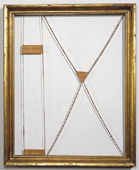The clunky, slowly rotating cams (as in camshaft, not webcams) in Douglas Repetto's just-ended installation at Location One reminded me of this piece by Francis Picabia, consisting of cardboard and string stretched loosely in a picture frame (sorry I don't know the work well enough to tell you what's written on the cardboard). In my copy of Brian Wallis' Art After Modernism, the Picabia serves as an illustration for Benjamin Buchloh's famous essay "Figures of Authority, Ciphers of Regression." It's arranged on the page in a before and after demonstration, with a later painting of Picabia's showing the artist posing with two beautiful women. The point supposedly being that Picabia was part of a wave of avant gardists from the 1910s who regressed to classical or conservative painting styles later in the 20th century. I always found it a hoot that Buchloh (or Wallis) thought Picabia's late work reinforced the status quo. What, bigamy? (Yeah, I know, fantasies of male over-empowerment, yadda yadda.) The man was never more out of favor with the art world than when he was painting nudie images out of French erotic magazines--those canvases didn't really become market-viable until relatively recently, after David Salle said "Hey, these are good!" There are inherent problems when a critic with absolutely no sense of humor uses an arch-ironist like Picabia to exemplify anything. Yes, Picabia wrote about the "return to order" in the '20s, but we should be talking about his art, not his spin du jour. It's arranged on the page in a before and after demonstration, with a later painting of Picabia's showing the artist posing with two beautiful women. The point supposedly being that Picabia was part of a wave of avant gardists from the 1910s who regressed to classical or conservative painting styles later in the 20th century. I always found it a hoot that Buchloh (or Wallis) thought Picabia's late work reinforced the status quo. What, bigamy? (Yeah, I know, fantasies of male over-empowerment, yadda yadda.) The man was never more out of favor with the art world than when he was painting nudie images out of French erotic magazines--those canvases didn't really become market-viable until relatively recently, after David Salle said "Hey, these are good!" There are inherent problems when a critic with absolutely no sense of humor uses an arch-ironist like Picabia to exemplify anything. Yes, Picabia wrote about the "return to order" in the '20s, but we should be talking about his art, not his spin du jour.
ahhh! I recognize that! It's the long lost critical axe! Grind it, Tom Moody, grind it!
|
The clunky, slowly rotating cams (as in camshaft, not webcams) in Douglas Repetto's just-ended installation at Location One reminded me of this piece by Francis Picabia, consisting of cardboard and string stretched loosely in a picture frame (sorry I don't know the work well enough to tell you what's written on the cardboard). In my copy of Brian Wallis' Art After Modernism, the Picabia serves as an illustration for Benjamin Buchloh's famous essay "Figures of Authority, Ciphers of Regression."
- tom moody 11-27-2005 10:24 pm
ahhh! I recognize that! It's the long lost critical axe! Grind it, Tom Moody, grind it!
- robert huffmann 11-29-2005 6:26 am